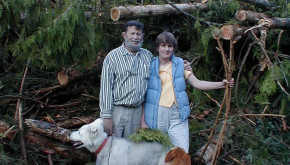
My parents and I have all, separately, taken a fantastic course about generational family planning for the private forest landowner: “Ties to the Land.” Both our courses were team led by the truly remarkable Kirk and Madeline David. My parents first took the course many, many years ago. Probably when this course first became available in Idaho!
My mom was a proactive person in our family, and she understood the need to communicate her desires for the continuation of our family forestland -- for legacy planning. Our land has not been in our family for generations, but not surprisingly I feel as if our land has been in our family for multiple generations. I have joyfully given years of sweat equity and much of this work was done with my mom right by my side: for example, pre-commercial thinning, planting seedlings, and controlling weeds. I would thin a few trees with the brush saw, and Mom would haul them away with her good arm. (In 1977, surgery, chemotherapy, and radiation treatment saved her life, but in the Nineties she lost the use of her right arm because of the radiation treatment. Mom carried on, doing more work with one arm than I could do with two. She was a 33-year survivor of breast cancer.)
I have a personal investment in our family’s forestland because of my labor on the land and my continued love of what my mom called “this small bit of earth.” It’s also quite clearly a deep and abiding connection to my mom now that she is no longer with us.
I took the course “Ties to the Land” many years after my parents; in fact, after Mom passed away two years ago from another new breast cancer that had then spread like root rot throughout her body. Mom and I had always spent a lot of time talking about the legacy of our family's stewardship forest. We would take a thermos of tea into the woods, sit and smell the cedar boughs, and talk.
One does not have to take a course, but for particular issues of generational family land planning, I think it is helpful to discover an extended community of support of like-minded folks who have grappled with similar issues. One finds out that personal concerns, which used to make me feel isolated, are common concerns for other landowners and their adult children.
One more note as we approach the Thanksgiving table: It may be a good idea, as suggested in “Ties to the Land,” to take family conversations about the land away from the Thanksgiving table! My sincere hope is to plan a family forestry meeting with my father, my older brother, and me—again, away from our land in a neutral place where all parties can talk.
My point about that neutral meeting place? The land needs to be the focus. Each family member has particular concerns and particular biases. If the land is the focus, those particularities may be more likely to slip away. If a meeting is held in a neutral place, it might be more likely to go well. We have not done this yet; it is one of my unfulfilled goals. I'm still learning how to speak up about my concerns and goals. My dad is the primary resident on our land and naturally has specific concerns about the land now. My mother is a great role model for her ability to voice issues calmly and clearly. Like my mom, I want to ensure the continuation of our family forestland. Where does my brother fit in the picture? My husband? We have no children! What happens to the land once my dad has passed on if I'm not around? How does one plan for all of this? How does one keep plans flexible and current?
I am so grateful during this season of blessings that my mom took the time over many years to speak with Dad and me about her deep love of our family forestland, her concerns about the forest, her desires for habitat renewal and stewardship, and her vision and goals. I am so grateful she and Dad planned for change years earlier (before Mom's passage) by creating a trust, by consulting a lawyer, by creating a solid will, and by communicating directly with me.
Please click here for more information about the "Ties to the Land" program started at Oregon State University.

